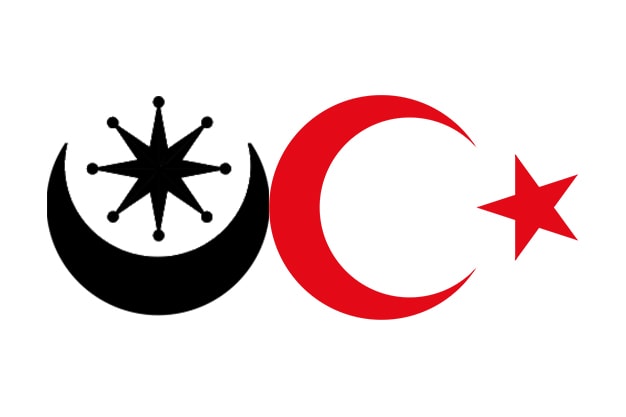
The star and crescent are a co-joined representation of the star and the crescent. The star and crescent design are developed back in the 2nd century in the iconography during the Hellenistic period. The star and crescent represented the sun and moon respectively. The star is usually inscribed within the arc of the crescent while the Moon (Crescent) lying side by side. In Byzantium, the symbol was associated with patron goddess, Artemis-Hecate which is a representation of Moon goddess commonly during the Roman era.
The Origin
The Crescents appearing with stars are common among the Sumerian iconology. The sun is depicted with Ishtar (Inanna) while the crescent the moon god Sin. By the late Bronze Age in Canaan, the star and crescent moon symbol was found on Moabites. The crescent and star motifs were later designed in the Bosporan Kingdom with no clear relationship with the art at Mesopotamia.
The Hellenistic era
Between (120- 63) BC, Mithradates Eupator of Pontus used an emblem designed by an eight-rayed star with a crescent moon. In 1986, McGing noted an association between the star and the crescent thereby explain the appearance the survival in the coins. During that reign, many interpretations were made with the star considered as a representation of the sun.
When the Roman era came, the star and crescent symbol were depicted by some level of Byzantium. This association made Hecate as the goddess of walls. The goddess had her origin in the Thrace. By around 340BC, the goddess was believed to have saved the city from the Philip of Macedonia attack by the help of a bright light in the sky.
During the 1st century, in Persia, the motif was the star and crescent appeared on some coins of the Partha kingdom, Elymais. Besides, the similar symbol appeared in in coins as an association with the Orodes I in the 5th century; the Sassanid coins had the symbols on their margins. Besides, the rulers of Sassanid used crowns bearing the star and crescent symbols. During the Roman Empire (2nd Century), the star within a crescent was notified on the Roman coins during the reign of Hedrain through to Septimius Severus.
The classical era
By late 12th century, the star and crescent motif was used on the medieval seals. During the 13th century, the crescent without a star was used by the western heraldry. By the 14th century, the combination of the crescent and star appeared in attributed arms as a coat of arms attributed to John Chrysostom.
Among the Roman Catholic, Virgin Mary symbol has been associated with the stars and the crescents as a depiction of a Woman of the Apocalypse. In Europe, the crescents were popularly used in 1605.
By late 18th century, the star and crescent symbol were adoptions were very low by the Ottoman Empire.
The description and usage
Islamic symbol of faith
The star and crescent motif are ancient associated with the Sun God and Moon God. The logo is a sign of the Islamic religion. In contradiction, some Islamic believe that crescent as not as a sign of faith.
The State flags
In some nations, the symbol of a combination of star and crescent are used in the design of their flags or separate stars and crescents. These symbols are on flags as Tunisia, Turkey, Pakistan and Algeria.
Symbol of power
The star and crescent are on some municipal coats of arms and the administration police as a sign of authority bearing. In the modern world, the stars without crescents have been used to show a degree of quality. For instance, cars with many stars are rated to be of higher quality compared to the ones with few stars.
Beauty symbol
Most decorative arts and designers have associated the star and crescent with beauty and a style. The design of jewelry products and even body tattoos are using the symbol of star and crescents as a sign of beauty.
Conclusion
It is clear that the star and crescent symbol an ancient motif. As result of attached attributes, different religious groups such as Roman Catholic and some Islamic have associated with spiritual representations. Besides, the world of decorative art has also significantly applied the symbols. Finally, some state flags bear the symbols.

